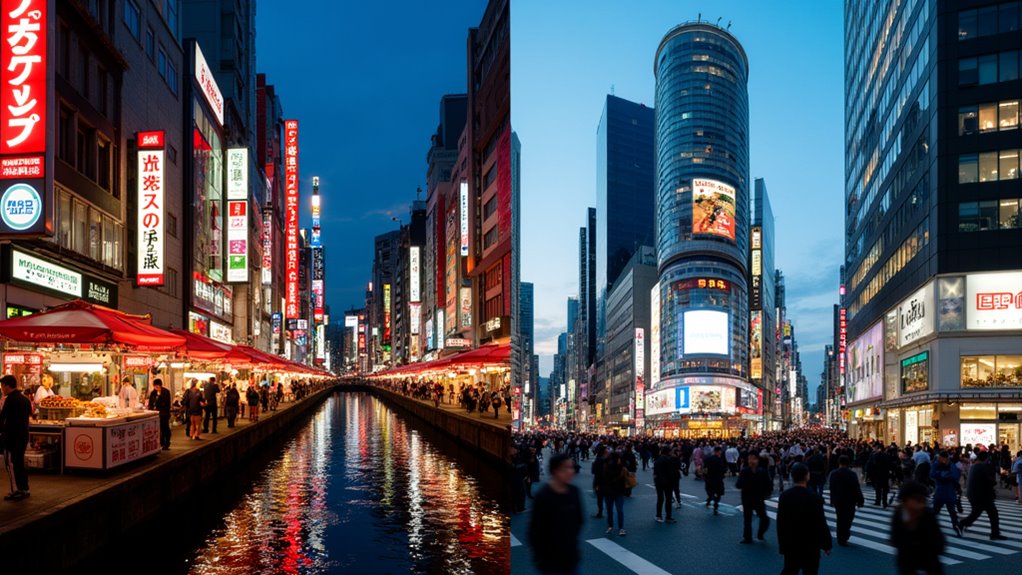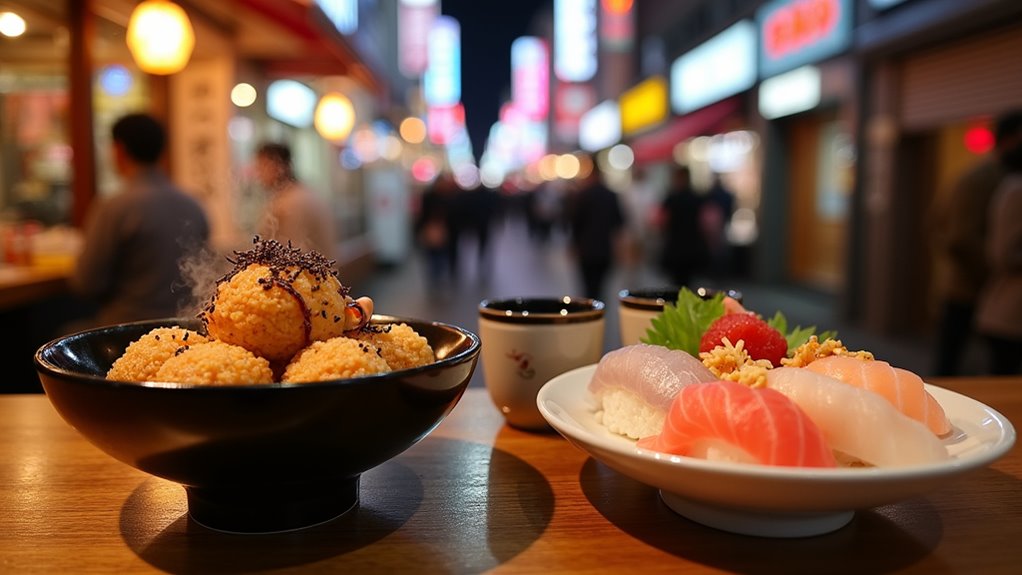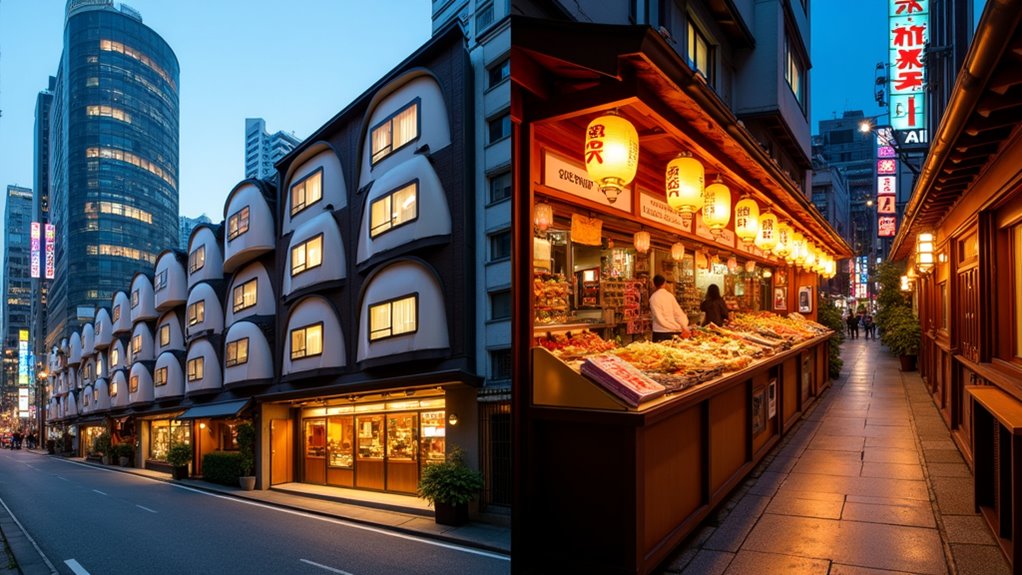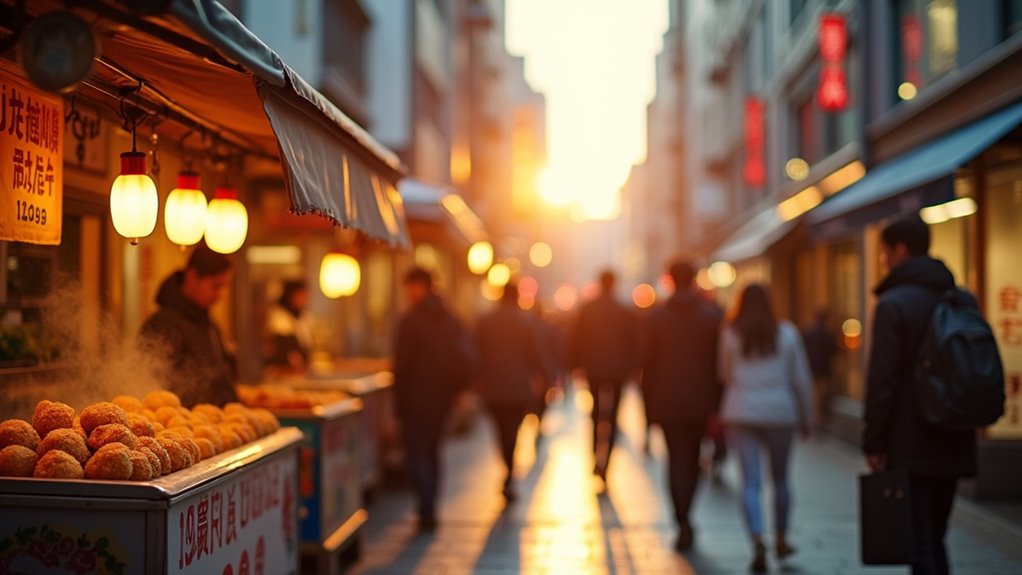Physical Address
304 North Cardinal St.
Dorchester Center, MA 02124
Physical Address
304 North Cardinal St.
Dorchester Center, MA 02124

In this ultimate Japan showdown, discover whether Tokyo's sleek sophistication or Osaka's vibrant street culture matches your travel personality.
Tokyo offers modern sophistication with subdued elegance, world-class dining, and complex transit systems, while Osaka delivers warm hospitality, street food paradise, and straightforward navigation. Choose Tokyo for cutting-edge experiences and formality or Osaka for down-to-earth charm and culinary adventures. Both cities provide excellent bases for day trips—Tokyo to Mt. Fuji and Osaka to Kyoto and Nara. Your ideal Japanese experience depends on whether you prefer polished restraint or outgoing authenticity.

While both Tokyo and Osaka form essential pillars of Japanese culture, their distinct personalities set them worlds apart despite sharing the same country. Tokyo, located in the Kanto region, embraces restraint and formality—you’ll notice Tokyoites remaining quiet on trains and offering polished, professional service.
In contrast, Osaka in the Kansai region pulses with warmth and spontaneity. You’ll encounter talkative locals who strike up conversations with strangers and inject humor into everyday interactions. Their customer service feels more personal and playful than Tokyo’s efficiency-focused approach. When chatting with Osaka locals, you might hear distinctive expressions like “Okini” instead of the standard Japanese “thank you.”
These differences extend to dining experiences too—Tokyo restaurants tend to be subdued affairs, while Osaka’s eateries buzz with lively conversation.
Historical and geographical influences have shaped these contrasting regional identities, giving you two authentically Japanese yet remarkably different experiences.
Both Tokyo and Osaka showcase Japan’s architectural grandeur through distinct landmarks that reflect each city’s unique character and history. Tokyo impresses with modern marvels like the Tokyo Skytree and the iconic Shibuya Crossing, while offering peaceful retreats at Meiji Shrine and the Imperial Palace East Gardens.
Osaka counters with its magnificent feudal-era Osaka Castle surrounded by cherry blossoms in spring. The vibrant Dotonbori district pulses with neon lights and street food energy, while Shitennō-ji stands as Japan’s oldest official Buddhist temple. Visitors to Osaka Castle should be prepared for many steps to reach level 8 where the best views are found.
For panoramic views, head to Abeno Harukas or Umeda Sky Building.
When planning your itinerary, consider that Tokyo’s attractions are more spread out, while Osaka’s landmarks can be explored more efficiently, saving you precious travel time.

Japan’s culinary landscape diverges dramatically between Tokyo and Osaka, offering travelers two distinct food experiences. Tokyo boasts the world’s highest concentration of Michelin-starred restaurants, innovative food trends, and bold, salty flavors. You’ll find high-end sushi alongside international cuisines spread throughout the city’s diverse neighborhoods.
Osaka, known as “the nation’s kitchen,” delivers a more casual, street food-focused experience. Here, you can wander through concentrated food districts sampling affordable local specialties like takoyaki, okonomiyaki, and kushikatsu. The flavors tend to be milder and sweeter than Tokyo’s robust seasoning.
The difference extends to atmosphere—Tokyo’s exclusive reservation-based dining contrasts with Osaka’s communal, accessible food culture. Tokyo’s culinary scene evolved from humble street stalls during the Edo period to today’s diverse metropolitan hub of innovation, while Osaka perfects traditional comfort foods with warm hospitality.
Traveling Japan’s two largest cities requires understanding their extensive but distinct transportation networks. Both feature thorough subway systems, but Tokyo’s is particularly larger and more complex.
Navigating Tokyo and Osaka demands mastering two sophisticated yet fundamentally different urban transit ecosystems.
In Osaka, the Loop Line and Keihan Railway offer straightforward navigation, while Tokyo relies on JR trains and numerous private railway lines.
Between cities, the Shinkansen bullet train is your fastest option at about 3 hours, costing ¥13,870 one-way. The bullet trains operate every 10-15 minutes throughout the day, ensuring flexible travel options. Budget travelers might prefer highway buses (8-10 hours) starting around ¥4,000.
Local transportation in both cities is affordable (¥200-¥400 per ride) and remarkably punctual.
Tokyo’s vastness makes its transit system more intimidating, while Osaka’s compact center allows for more walking between attractions.
Consider a JR Pass if you’ll make multiple intercity journeys.

When choosing where to stay in Japan’s major cities, you’ll find distinctly different accommodation landscapes between Osaka and Tokyo. Osaka generally offers more budget-friendly options across all categories, from business hotels like APA to capsule accommodations like Anshin Oyado.
Tokyo presents a wider range of high-end stays, including prestigious properties like Park Hyatt Tokyo, but at steeper prices. Both cities feature capsule hotels and business chains, though Tokyo adds more apartment hotels suitable for families. For travelers booking late for May visits, expect limited options particularly in Osaka due to the expo.
For neighborhoods, consider Osaka’s lively Dotonbori and Shinsaibashi for nightlife and shopping, or Umeda for transportation connections.
In Tokyo, Shinjuku offers urban energy, Asakusa provides traditional charm, and Shibuya delivers youthful vibrancy. Your choice ultimately depends on preferred atmosphere and proximity to attractions you’ll visit.
The seasons dramatically influence your travel experience in both Osaka and Tokyo, with each offering distinct advantages throughout the year. Spring (March-May) brings cherry blossoms and comfortable temperatures to both cities, while autumn (September-November) offers vibrant foliage and festive atmospheres.
Tokyo maintains slightly warmer temperatures year-round compared to Osaka, though Osaka experiences hotter August days. Both cities endure humid summers above 30°C and share a June-July rainy season, with typhoon risks through October. Osaka receives more annual rainfall than Tokyo, with approximately 37.4 inches compared to Tokyo’s 23.2 inches.
For the best experience, visit either city during spring or autumn to avoid summer’s humidity and tourist crowds.
Winter provides milder conditions than you might expect, with temperatures rarely dipping below freezing, plus seasonal illuminations and cultural events like oden festivals in Osaka.

Budgeting wisely can make or break your Japanese vacation, with notable cost differences between Tokyo and Osaka affecting everything from your accommodation to daily expenses.
While Tokyo hotels range from $80-200 nightly, Osaka offers slightly cheaper options at $60-150. For budget travelers, hostels cost $20-40 in Tokyo and $15-30 in Osaka. Osaka hotels often include premium amenities like all-day onsen access and complimentary extras that add significant value to your stay.
Both cities have affordable public transportation (¥100-300 per ride), though Osaka’s system might save you a few yen.
Food costs remain comparable, with mid-range meals running $10-20 per person in either city. Osaka’s street food scene offers exceptional value with $3-7 meals.
For attractions, temples and shrines are generally free or inexpensive in both locations, while theme parks exceed $60 per ticket.
Both Tokyo and Osaka serve as excellent base camps for exploring Japan’s diverse attractions, offering day-trippers numerous options within a two-hour radius.
From Tokyo, you’ll find historic Kawagoe (“Little Edo”) less than an hour away, featuring preserved Edo-period architecture. Nature lovers can head to Lake Kawaguchiko for Mount Fuji views or explore the dramatic cliffs along Jogasaki Coast. Yokohama is easily accessible in just 20-30 minutes via express trains, offering Japan’s largest Chinatown and panoramic city views. Don’t miss traditional Shuzenji Onsen with its 1,200-year-old temple.
Osaka’s strategic location puts Kyoto’s imperial palaces and temples just 30-45 minutes away by train. You can visit Nara’s UNESCO sites and feed friendly deer within an hour, or enjoy Kobe’s renowned beef and Harborland waterfront after a quick 30-minute ride. Himeji Castle and its adjacent Koko-en Garden make another perfect day excursion.
You’ll find that choosing between Tokyo and Osaka isn’t the dilemma you think it is. While Tokyo dazzles with its orderly chaos and futuristic skyline, Osaka charms with its down-to-earth warmth and culinary treasures. Ironically, the city you don’t choose will inevitably call you back to Japan. Budget for both if possible—the true Japan experience lies in appreciating these contrasting urban personalities rather than picking just one.